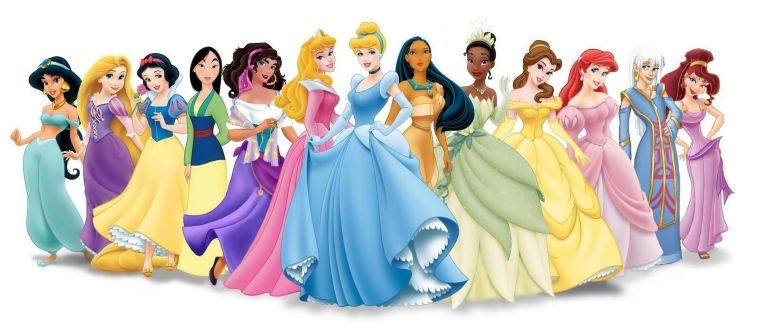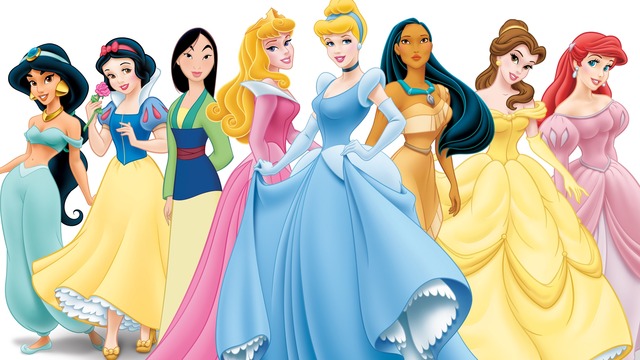During my past two years at Brock University I have come across the phrase, “can I be a Disney Princess already?” many times. Usually this would be said at times of stress when we all would rather be a “princess” and not have to go to school than deal with our responsibilities. During this day and age we often joke about wanting to be a princess, not taking into account that we are playing into societal roles. I don’t believe that we as young adults, take into account how Disney Princess movies influenced us and still do in children’s lives these days.
 In my Child and Youth course I am taking, we discussed gender socialization. How we are born into this world having to learn the norms of society. This made me think about Disney princesses and how children internalize gender roles. If Disney was a big part of your childhood like it was mine, it implemented gender roles much more than you noticed at a young age. Growing up I have noticed the stereotypes portrayed in movies more and more but had never really realized the specifics until recently.
In my Child and Youth course I am taking, we discussed gender socialization. How we are born into this world having to learn the norms of society. This made me think about Disney princesses and how children internalize gender roles. If Disney was a big part of your childhood like it was mine, it implemented gender roles much more than you noticed at a young age. Growing up I have noticed the stereotypes portrayed in movies more and more but had never really realized the specifics until recently.

We notice a domestic trend in these Disney movies. This can be seen in the first Disney princess movie Snow white and the Seven Dwarfs (1937), when she comes to the Dwarfs house and sees a mess, her response is, “you’d think their mother would clean”, teaching that mothers are like “maids” of the house. In Cinderella (1950) when the fairy godmother shows up to get her ready for the ball, the male mice offer to help but the female mice are saying “ leave the sewing to the women”. In Mulan (1998), a soldier sings, “ I could care less what she’ll wear or what she looks like. It all depends on what she cooks like”. These movies are demonstrating “norms” that girls should retain domestic skills and that is how they play a role in society.
Other than the lifestyle that is portrayed for women, the physical image of women themselves seem to be embedded in girls minds that Disney Princesses are what every girl should look like. The long hair (with the exception of Snow White), the thin waste with a bustier chest, tall thing legs, and big eyes with the “perfect” bone structure. For me the appearance has not influenced myself to change my body to what society thinks how every girl should look like. Sadly there are some women who are influenced strongly by societal norms of how gender is defined and portrayed. Relating to Disney Princess movies, there is this one specific case that shocked me, her name is Sarah Ingle. Sarah seems to have the “princess look” already but she went and spent $14,000 on custom princess gowns making a career of dressing like a princess. She has all the wigs and she uses coloured contacts depending on the princess. Her goal is to one day be a “real princess”.
What I have discussed demonstrates how influential Disney is to girls. It implements stereotypes and gender norms into movies to persuade young girls to want to be something they are not. Sure it might be nice to not have responsibilities all the time but we need to understand the opportunity women have these days to prove their worth and have more than just a domestic role in life.
Although Disney Princess movies have the main audience of females, they portray the societal roles and stereotypes of men as well. They are demonstrating how men should know women’s place in society and what their place is as well. In Beauty and the Beast (1991), Gaston says to Belle “It’s about time you got your head out of those books and paid attention to more important things. Like me”. Demonstrating to both boys and girls that girls do not need an education and they just need to find a man to provide for them. Male main characters in these movies are the masculine “ pretty boy” princes who are to “rescue” the vulnerable princesses and then they live happily ever after. These movies portray the societal roles of how women need to find a man to rescue them and for the man to provide them with a better life.

As much as I love Disney, there is much controversy over the messages the Disney Princess movies give off. I think we have come a long way with gender equality and gender roles, but will society ever move away from the expected “gender norms” and stereotypes?








I never thought about Disney princess’s roles in the movies and how they affect children and youth’s views on what is accepted or I guess I should say what is considered the “norm” and the standard for women. Particularly how the role of women doing the domestic work is prominent in these films. I obviously always considered the way the princess dress and present themselves is influential on young children, especially girls but not the domestic work. I find this interesting, as you mentioned these films are very popular and therefore children learn to idolize these princess and the work that they do. However, the message about females doing all of the house work doesn’t offer the children with a diverse view of the kind of work women are capable of doing. I think this idea can be transferred to many movies and TV shows, not just Disney. It is rare to see a male taking on the domestic work in movies and TV shows, which just goes to show how society has really pushed this view of women onto us. The last image you provided of the princesses really drove home this topic for me, I have a new realization of the controversial message that these Disney movies are providing for children and youth. I really liked your creativity with the topic, I definitely think more awareness about this issue should be raised
LikeLike
Your blog really was able to trigger provoking thoughts on how gender norms are portrayed in Disney princess movies. Disney movies were heavily influenced in my childhood as well where I was constantly watching the movies and my mom was always buying Barbie’s because I liked to comb their long hair and put them in the princess dresses that those Barbie’s came with. I never really noticed these gender norms portrayed within these movies until now because I certainly didn’t think about it when I was younger. All my Disney Barbie’s had the same thin waste, tall thin legs, and big blue eyes with the “perfect” bone structure. Now that I think of it, I never had a Barbie that wasn’t portrayed as the societal norm of what a woman was supposed to look like. I never had a Barbie with a dark completion or with a bigger waste and bigger thighs. I agree that these Disney movies portray femininity as well as masculinity, where the Princesses are cleaning up the houses and the Princes are the really muscular men that these princesses end up with. This is how society has taught us; that we NEED bigger men to protect us from whatever harm comes our way. It’s actually interesting, my friend is a singer and she auditioned for a Frozen Princess singing job. Mind you, she’s really skinny, she’s tall and she very pretty and I wonder if that’s why she ended up being picked as a singer to perform as Elsa and Anna. My friend would get all dolled up (wigs, extreme amounts of makeup and heels) and would go to parties and sing Frozen songs to all the kids at the birthday party. I thought this story was relatable because our generations today are still trying to mask this reality that princesses are beautifully skinny and tall, just like in the movies. I think the overall messages these movies convey are dangerous if a girl wants to be like them and masks a reality that isn’t necessarily true. However, Barbie is becoming more diverse with colour and body types and I think this is a good way to show society and little girls that Barbie isn’t ideal and being bigger with darker complexions is okay.
LikeLike
Hi Leah,
I think your post was really well done and left me thinking about how Disney Princess movies have influenced myself. When looking back I was able to remember the times when I was a child and really wanted to be a princess. I know that today I am not so influenced by the Disney Princess imagine and figure as there is not something I tend to care about. You mentioned in your blog that a girl named Sarah Ingle spent all kinds of money trying to be just like a princess; something I think you would find interesting is that Disney World/Land actually now has a store that is dedicated to allowing little girls and boys to be decked out in princess and prince outfits for a crazy amount of money. My neighbour’s daughter actually did it and said she spent about $200 so her child could have it all. You also mentioned the gender roles that are portrayed in the movies that women need a man to rescue them. Well the last couple of months on social media I have come across videos of little kids crying to the camera saying they need a man at such a young age and when they are told no they freak out about being told no. ¬I feel like compared to when I was a children kids today are being influenced by these videos so much more because they are able to recognized it in other places, but when we were watching it we just like to movies and all the colour. There is such a difference from then till now, that we need to be more aware of how children are interpreting movies and how we enforce the gender roles on the child in order to let them express themselves the way they wish to do so.
Thanks for the good read!
Emily Edmonds
LikeLike
I found your blog very interesting to read. I completely agree with your opinion that gender roles and stereotypes are reinforced throughout movies, specifically for women through Disney princesses. You can also look at how these movies are reinforcing the view of men and how they are supposed to act in order to fit into societal norms. The men (princes) must be seen as strong, independent, capable, providers, fearless and not emotional. I like how you pointed out that through the men’s actions and language help to reproduce female stereotypes, such as domestic work, but you can also see how the princess’s actions and language also reproduce stereotypes of gender roles for the males. By Disney portraying the princesses as weak and incapable of being alone, leaving them dependent on a man, the prince’s are always portrayed as the provider and being strong. A Disney princess being saved by a weak man is unheard of, the men are not portrayed as having any feminine characteristics as this may cause detrimental harm to societal views of the princes status (or Disney makes it seem this way anyway). Not only did I like your argument, I also really liked the picture you included at the end of your article, I think it really helped prove your point.
– Samantha Daniel
LikeLike